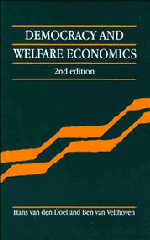5 - Representation
Published online by Cambridge University Press: 03 May 2011
Summary
Elected representatives
In chapter 4 we explained why, under certain conditions, an iron law of oligarchy operates in a direct democracy; this is because, in order to avoid high decision-making costs, all individuals accept a decision rule by which decisions are made by a small group. This small group can consist of a minority which makes decisions completely independently of the other individuals. In a modern democracy, however, this small group consists of specialised ‘agents’ who have been chosen by all individuals. In such a case, there is no longer any question of a direct democracy, but of an indirect or representative democracy. Largely following Buchanan and Tullock (1962, pp. 211–17), we understand representative democracy to be a method which on the one hand avoids the high costs of decision-making associated with a large number of decision-makers and, on the other, precludes the external costs associated with dictatorship or oligarchy.
In this chapter, we shall assume that the individual voters will be represented by ‘politicians’ who combine the wishes of the voters and turn them into concrete proposals, weigh the interests of the various voters, and decide on the proposals by a majority of votes. In this definition, the category of politicians includes: committee members of societies and political parties; members of community councils, of town councils, of county councils; parliament; the prime minister and, except in a presidential system, also the members of the cabinet.
- Type
- Chapter
- Information
- Democracy and Welfare Economics , pp. 116 - 147Publisher: Cambridge University PressPrint publication year: 1993



